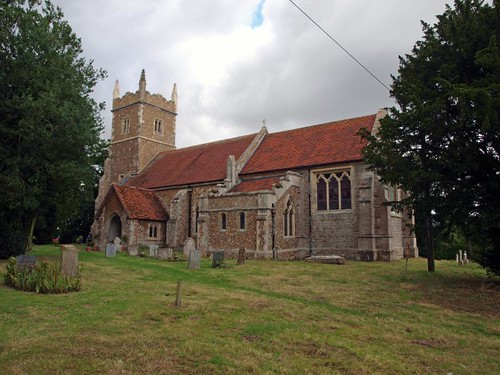ST STEPHEN. 1885 except for the C14 nave. The Victorian building makes use of old materials, but there is nothing of special interest, old or new. - FONT. Octagonal, Perp, bowl with panels filled by shields in quatrefoils or rosettes. - PLATE. Cup, late C16, but altered; Paten also of the late C16. HYDE FARM, W of the church. C15, partly timber-framed and partly brick-built.
GREAT WIGBOROUGH. Those who live here still thrill to the memory of the events of one of the dark nights of terror in the first years of the Great War. It is in the tower that we are reminded of it, for on the tower arch hangs a piece of the girder of a Zeppelin which fell on these fields below on September 24, 1916. Framed in metal from it is a printed record of that dread event, telling how the crew surrendered to the village constable after firing their monstrous machine, and how statesmen and generals came to Wigborough to see this new enemy of the air, which at that time was striking terror at the hearts of our people. We have lived through the Battle of Britain since then, but few villages can have known a more thrilling day than that on which a plain policeman received the surrender of this Zeppelin crew.
The oldest house here, Hyde Farm, was begun 500 years ago. Some of its original timbers support the tiled roof, while from a chimney peers forth a gargoyle which came from Little Wigborough. A lane leads us up the hill to the church, set in a ring of ancient elms. Across the valley we see Peldon church dominant on its hill, the tiled and thatched roofs of a farmstead in the hollow breaking the green curve of the meadows. It is hard to believe that John Ardley and John Simson, who roamed these sun-bathed fields as boys, ended their lives in Mary Tudor’s fires, an English terror centuries older than the German Zeppelin.
The stone tower was rebuilt after an earthquake in 1884, but a battered door in its turret is 500 years old; so are many of the timbers in both porch and nave. An old niche of great beauty faces the entrance, and the font, with roses on its bowl, may have been carved by the same 16th century craftsman. A bright note is given to the chancel by a reredos with five paintings of Fra Angelico’s heavenly makers of music.
Simon K -
The oldest house here, Hyde Farm, was begun 500 years ago. Some of its original timbers support the tiled roof, while from a chimney peers forth a gargoyle which came from Little Wigborough. A lane leads us up the hill to the church, set in a ring of ancient elms. Across the valley we see Peldon church dominant on its hill, the tiled and thatched roofs of a farmstead in the hollow breaking the green curve of the meadows. It is hard to believe that John Ardley and John Simson, who roamed these sun-bathed fields as boys, ended their lives in Mary Tudor’s fires, an English terror centuries older than the German Zeppelin.
The stone tower was rebuilt after an earthquake in 1884, but a battered door in its turret is 500 years old; so are many of the timbers in both porch and nave. An old niche of great beauty faces the entrance, and the font, with roses on its bowl, may have been carved by the same 16th century craftsman. A bright note is given to the chancel by a reredos with five paintings of Fra Angelico’s heavenly makers of music.
Simon K -
The road north skirted the east side of the vast Abberton reservoir,
and remote its village and set beyond the woods is St Stephen.
Locked with a keyholder notice. Despite its complete destruction and
rebuilding after the earthquake of 1884, the exterior and the setting
is everything, on a high bluff overlooking the valley below. Red
sandstone and puddingstone abound, and the tower top is only just now
being finished. The day was drawing in and I didn't have time to chase
a key - I'll come back next summer.

No comments:
Post a Comment